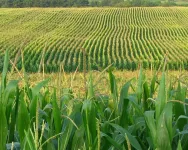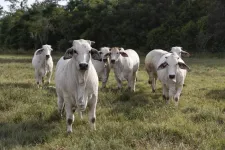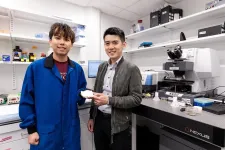(Press-News.org) Corn is one of the planet’s most important crops. It not only provides sweet kernels to flavor many dishes, but it’s also used in oils, as a sweetener syrup, and as a feed crop for livestock. Corn has been bred to maximize its yield on farms around the world.
But what will happen under climate change? Research led by the University of Washington combined climate projections with plant models to determine what combination of traits might be best adapted to future climates. The study used projections of weather and climate across the U.S. in 2050 and 2100 with a model that simulates corn’s growth to find the mix of traits that will produce the highest, most reliable yield under future conditions across the country.
The open-access paper was published in April in Environmental Research Food Systems. UW News asked senior author Abigail Swann, a UW professor of atmospheric sciences and of biology, about the study and its findings.
Our future climate will be warmer, have drier air and have a higher concentration of atmospheric carbon dioxide. Is there a broad understanding of how all these changes together will affect plant growth?
Abigail Swann: For corn, a previous study by our group found that higher temperatures and drier air have about the same size impact, with both leading to less corn yield, while more CO2 available for photosynthesis increased yield. The increase in yield from CO2 wasn’t enough to counteract the decrease from the other two changes, however, so corn yields went down overall.
Overall, hotter temperatures like those we expect in the future will make crops grow faster but be less productive. Of course, shifts in precipitation also affect their growth in different locations, though that has less impact overall, and particularly for agricultural crops that rely on irrigation.
Typically, many people think of climate change as something that will shift where certain crops can grow. Your study says the crop varieties we plant today aren’t ideal for any location in the future. Why is that?
AS: As climate continues to warm, we can adapt by moving existing crop varieties closer to the poles, where the air is cooler. But shifting existing varieties to new places isn’t enough to make up for the loss in crop yield that we expect in a hotter climate because the impacts of higher temperatures are so detrimental.
Our study looked at 100 possible corn varieties, and we find that those that will be most successful in the future are not varieties that are successful now — we need new crops for the new climate.
Can you describe the corn that will perform best in future climates, according to your study, compared to the varieties that do best today?
AS: Corn plants first grow leaves, and then switch to growing grain. We find that today, corn plants must make a tradeoff between growing a lot of leaves and still having enough time left in the growing season to grow a lot of grain. This means the most successful varieties today don’t grow very many leaves, so they can switch to growing grain early in the season.
Growing more leaves could potentially allow corn to increase how much the plant can photosynthesize, which would also increase how much grain it could grow, but today this comes at a cost of a shorter growing season.
In the future, it will be warmer overall, and corn may be planted earlier and harvested later in the season. This longer growing season relieves corn from this tradeoff and allows it to both grow more leaves and still have plenty of time to grow grain (there is an additional boost from faster growth under hotter temperatures).
So basically, in this sense the corn plants of the future can have their cake and eat it too. The varieties we simulated that took advantage of the ability to grow more leaves yielded more under future climate than the varieties with less leaf growth. This isn’t good news for corn, though. While corn will be able to grow more leaves and still have plenty of time to grow grain, the adverse impacts of hot temperatures and drier air will decrease the overall yields. Growing more leaves and having a longer growing season help buffer these adverse impacts, but overall, all of the corn plants we simulated did worse under future climate conditions.
Is there any way to verify these results on real plants before these climate conditions become reality?
AS: While the plants that we found would do best under future climate conditions don’t exist right now, plants with many of these characteristics can be bred quickly, using genetic techniques like CRISPR. Then they can be grown under controlled climate conditions to see if our findings hold up for real plants. That part of the process is surprisingly fast, so we can create and trial new plant varieties before they are needed.
Why is it helpful to use computer models, rather than just selective breeding as has been done in the past?
AS: Breeding new crop varieties is a very slow process. It can take decades to go from initial breeding to testing and adoption by farmers. The process starts with selecting among the existing crop varieties for desirable characteristics, including high yield. Then these new potential varieties are combined, grown and tested in multiple environments and with different management. Finally, the final varieties are released commercially and then can be adopted by farmers.
With simulations we can test a much wider range of possible combinations of characteristics that could work well for a new variety, and use that knowledge to guide the first stages of breeding. This can speed up the breeding process and accelerate our ability to adapt to a changing climate. It also gives us information about what characteristics we might try to create that are farther from our existing varieties.
How does your study fit into the broader field of climate adaptation?
AS: We will need to adapt agriculture in many ways to support a growing population with a growing demand for food, combined with the loss in crop yield that we expect as climate gets hotter. Our study helps to jumpstart the process of breeding climate-resilient crops by envisioning what those crops should look like. Our study also provides a blueprint for how to do this analysis for other crop types, besides corn.
Although we focus on corn for this study, we see our work as a demonstration of an approach that can be applied to any crop, and so more of a blueprint of how we can incorporate the expected impacts of climate change into the breeding of new crop varieties.
In the U.S. we heard recently about population leveling off due to lower birth rates and about shifts to less resource-intensive, plant-based diets. Can you explain why, worldwide, we still expect an increase in demand for corn?
AS: Worldwide population is still growing, and in addition to growing in total number, the global population is growing more affluent and increasing its consumption of meat. In the U.S. our diet is already very meat-intensive, and so shifts towards less resource-intensive and plant-based diets make a lot of sense from a health and environmental standpoint.
But meat consumption in many parts of the world is currently very low. As these populations increase their wealth, we expect that in some cases meat consumption will grow. This increase in wealth is a good thing for the well-being of those people. By adapting agriculture, we hope to buffer the losses in yield expected from hotter temperatures and help provide enough food for everyone.
What’s next for this research?
AS: We would like to work with breeders to create some of the corn varieties our study proposed, and do similar studies on other major global food crops. We are currently seeking additional funding sources to conduct these next steps.
Lead author Jennifer Hsiao did the work as part of her UW doctoral degree in biology. Co-authors are Soo-Hyung Kim, UW professor of environmental and forest sciences; Dennis Timlin at the U.S. Department of Agriculture; and Nathaniel Mueller at Colorado State University. The research was funded by the National Science Foundation, the U.S. Department of Agriculture and the UW’s Royalty Research Fund.
END
Q&A: Finding varieties of corn that are adapted to future climates
2024-06-13
ELSE PRESS RELEASES FROM THIS DATE:
Does exercise in greenspace boost the individual health benefits of each?
2024-06-13
By Ann Kellett, Texas A&M University School of Public Health
Health practitioners and fitness buffs have long known that regular physical activity offers numerous health benefits, including the prevention of chronic conditions such as cardiovascular disease, diabetes, some cancers and osteoporosis.
In addition, exercise enhances immune function and pain control, reduces fall risk and extends life expectancy. Mental health benefits include improved mood, reduced anxiety and decreased ...
New insights into the brain regions involved in paranoia
2024-06-13
New Haven, Conn. — The capacity to adjust beliefs about one’s actions and their consequences in a constantly changing environment is a defining characteristic of advanced cognition. Disruptions to this ability, however, can negatively affect cognition and behavior, leading to such states of mind as paranoia, or the belief that others intend to harm us.
In a new study, Yale scientists uncover how one specific region of the brain might causally provoke these feelings of paranoia.
Their novel approach — which involved aligning data collected from monkeys with human data — also offers ...
Privacy-enhancing browser extensions fail to meet user needs, new NYU Tandon School of Engineering study finds
2024-06-13
Popular web browser extensions designed to protect user privacy and block online ads are falling short, according to NYU Tandon School of Engineering researchers, who are proposing new measurement methodologies to better uncover and quantify these shortcomings.
Led by Rachel Greenstadt, professor in the NYU Tandon Computer Science and Engineering (CSE) Department, the team will present its study at the 19th ACM ASIA Conference on Computer and Communications Security, taking place July 1–5, 2024 in Singapore.
Through ...
Sweaty cattle may boost food security in a warming world
2024-06-13
Sweaty cows may not sound like the most exciting company, but in a warming world, researchers can’t get enough of them.
When cattle are too hot, they tend to stop eating, said Raluca Mateescu, University of Florida Institute of Food and Agricultural Sciences (UF/IFAS) professor in the department of animal science. This affects the cattle’s health and growth and threatens the longevity of the food supply coming from that herd.
Climate change is making it more difficult to raise cattle – growth and reproduction are affected by heat – so ...
Researchers issue ‘call to action’ for data on more diverse range of dog owners
2024-06-13
Virginia Tech’s Audrey Ruple and Courtney Sexton, already deeply involved in data collection and analysis for dog health and connections to humans through the Dog Aging Project, are imploring fellow scientists to cast the net even wider for data on the shared environments of humans and dogs in a perspective piece that appears this month in the journal Science.
“Human environments and the impacts of environmental factors can vary substantially, and this variation should be captured by future studies of dogs to more accurately assess exposure risks for different and vulnerable populations,” ...
UTA awards more than $130,000 to spark new research
2024-06-13
The Office of the Vice President for Research and Innovation at The University of Texas at Arlington has granted 10 Research Enhancement Program (REP) awards valued at more than $130,000 to support new research initiatives.
The REP grant serves as seed funding for launching new research, providing a foundation for recipients to pursue future research and funding from external sources.
“UTA is committed to fostering a culture of innovation and research discoveries for our community of scholars,” said Kate C. Miller, vice ...
The Protein Society announces its Protein Science 2023 Best Paper recipients
2024-06-13
LOS ANGELES, CA
The Protein Society is proud to announce that the winners of the 2023 Protein Science Best Paper awards are Evan T. Liechty from the University of Colorado, USA, and Sophie Rizzo, from Lehigh University, USA.
Evan T. Liechty
Protein Science 2023 August;32(8):e4719.doi:10.1002/pro.4719
Analysis of neutral mutational drift in an allosteric enzyme
Evan T. Liechty1, Andrew Hren1, Levi Kramer1, Gregory Donovan1, Anika J. Friedman1, Michael R. Shirts1, Jerome M. Fox1
1Department of Chemical and ...
A conservation market could incentivize global ocean protection
2024-06-13
(Santa Barbara, Calif.) — The countries of the world agreed: Our planet needs more protection from human activity. And with the globe facing an assortment of environmental crises, they realized the plan needed to be ambitious. Thirty-by-thirty was their proposal: protect 30% of the planet by 2030. But while conservation is popular in principle, the costs of actually enacting it often stall even the most earnest efforts.
Three researchers at UC Santa Barbara have proposed a market-based approach to achieving the 30x30 targets in the ocean. They tested whether a system that allowed countries to trade conservation ...
New fabric makes urban heat islands more bearable
2024-06-13
This year has already seen massive heatwaves around the globe, with cities in Mexico, India, Pakistan and Oman hitting temperatures near or past 50 degrees Celsius (122 degrees Fahrenheit).
As global temperatures and urban populations rise, the world’s cities have become “urban heat islands,” with tight-packed conditions and thermal radiation emitting from pavement and skyscraper trapping and magnifying these temperatures. With 68 percent of all people predicted to live in cities by 2050, this is a growing, ...
Public more confident connecting increasing heat, wildfires with climate change than other extreme weather events, study finds
2024-06-13
Oregon State University researchers found that U.S. adults are fairly confident in linking wildfires and heat to climate change, but less confident when it comes to other extreme weather events like hurricanes, flooding or tornadoes.
The recent study found that politics and personal experience played significant roles in people’s responses: Self-identified Republicans were less likely than Democrats to attribute extreme weather events to climate change, though Republicans who had personally experienced negative impacts from extreme weather events were more likely to link them to climate change than those who hadn’t.
Looking at ...






